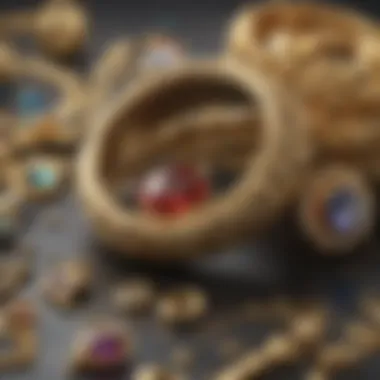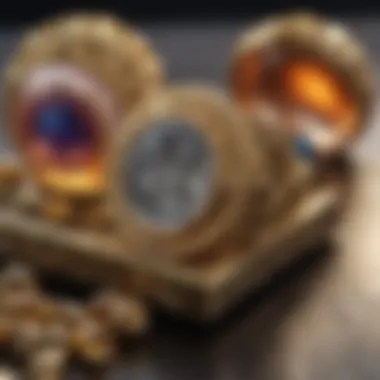Effective Methods for Cleaning Gold Jewellery


Intro
When it comes to gold jewellery, knowledge is power. It’s more than just shiny pieces adorning our fingers or necks; gold jewellery carries emotional weight, family history, and often financial investment as well. However, keeping that cherished gleam can prove to be a bit of a puzzle.
Instead of tossing your gold items into any random cleaning solution or using whichever rag happens to be nearby, it’s key to understand the nuances of what makes gold such a beloved metal. Not only are the cleaning methods you use important, but knowing what isn’t recommended can save you from potential heartaches.
This guide trails through effective methods for cleaning your gold jewellery, spotlighting techniques, agents, and preventive measures that ensure your treasures maintain their charm for years to come.
Overview of Gold Jewellery’s Characteristics
Gold itself is a unique metal, distinguished by its malleability, resistance to corrosion, and captivating shine. But let’s delve into specifics:
- Purity Levels: Gold isn’t always pure; its value and durability depend significantly on its karat rating. Gold jewellery commonly comes in 10K, 14K, 18K, and 24K varieties. The higher the karat, the purer the gold, and naturally, 24K is considered pure gold.
- Alloys in Gold: To enhance durability, gold is often alloyed with other metals like copper, silver, or palladium. This affects not just strength but colour and overall maintenance as well. Different alloys can react differently to cleaning materials.
So, before you grab a cleaning tool or solution, understanding the basic makeup of your gold jewellery can save you a lot of trouble.
Let’s take a look at the properties of gold and how they relate to cleaning methods.
Understanding Gold Jewellery
Understanding gold jewellery is fundamental to its care and maintenance. Gold has been cherished for its beauty and value for centuries. As a material, it’s not just about aesthetics; one must also recognize its unique properties, strengths, and vulnerabilities. Gold jewellery often represents significant personal or cultural value, making it essential to keep these pieces in pristine and shiny condition.
Types of Gold Alloys
Gold does not usually exist in its pure form when crafted into jewellery. Instead, it is combined with other metals to form alloys, which enhance both durability and appearance. The purity of gold is measured in karats, with 24K gold being pure gold. Here are some common alloys:
- 18K Gold: Composed of 75% gold and 25% other metals like copper or silver. This blend provides a good balance of durability and luster.
- 14K Gold: Contains 58.3% gold. A popular choice for many types of jewellery, including engagement rings, 14K gold is harder than higher karat options, making it resilient to wear and tear.
- 10K Gold: Made of 41.7% gold, it is the minimum karat for gold to be legally termed as gold in several countries. Its strength and affordability make it a favored option for those on a budget.
Each alloy has its characteristics, making some better suited than others for everyday wear. This understanding plays a crucial role when selecting cleaning methods as certain alloys may require specific approaches to maintain their sheen without causing damage.
Common Gold Jewellery Designs
Gold jewellery comes in various designs, resonating with personal taste and cultural significance. Some popular designs include:
- Rings: From simple bands to intricate settings with gemstones, rings can indicate commitment or serve as personal statements.
- Necklaces: Chains, pendants, and chokers can enhance an outfit's elegance or become treasured heirlooms.
- Earrings: Studs, hoops, or dangling pieces can add charm and are often considered essential for any jewellery collection.
- Bracelets: These can range from delicate chains to robust cuffs, making them a versatile accessory.
Each of these pieces can retain significant sentimental and monetary value, emphasizing the necessity for effective cleaning and maintenance to keep them looking their best.
Why Cleaning Matters
Cleaning gold jewellery should not be viewed as a mere chore but rather a meaningful practice to preserve its beauty and longevity. Over time, dirt, sweat, and environmental factors can tarnish or dull gold’s shine. This not only diminishes the aesthetic value of jewellery but can also lead to more severe issues, like erosion or permanent damage if not addressed promptly.
"Regular cleaning minimizes the risk of tarnish and reinforces the structural integrity of jewellery, ensuring it lasts for years to come."
Additionally, keeping gold jewellery clean can prevent skin irritations that might stem from accumulated dirt and oils. A good cleaning routine allows the wearer to enjoy their pieces without worry, maintaining both their brilliance and wearability.
Signs Your Gold Jewellery Needs Cleaning
Recognizing when your gold jewellery needs a little TLC is crucial for maintaining its beauty and longevity. Much like a beloved book that gathers dust, jewellery can lose its luster over time. Knowing the signs is the first step toward restoring that sparkle.
Tarnish and Discoloration
Tarnish often sneaks up on us like an unexpected guest at a dinner party. It's typically a dull film or a noticeable change in color that settles on the surface of the jewellery, stemming from exposure to air and moisture. Even though gold is less prone to tarnishing compared to other metals, certain alloys can still develop a tarnished look. When you spot the beginnings of that unwanted hue, it’s a telltale sign that a cleaning ritual is in order. Sometimes, even slight discoloration can suggest that the piece is alloyed with metals like silver or copper, which tarnish more easily.


Not only does tarnish affect the aesthetic appeal, but it can also signify the presence of acid or chloride buildup from skin or environmental exposure, which can corrode the metal over time. It’s vital to be vigilant; if tarnish is left untreated, it can lead to more severe issues down the line. In fact, a well-timed cleaning can easily restore the original brilliance, making your taped-together memories spark again.
Dirt and Oil Buildup
Dirt and oil buildup often goes unnoticed, quietly accumulating on your precious pieces as part of daily wear. Just like fingerprints on a window, our skin oils, lotion residues, and dirt can cling to the jewellery, dulling its surface. Over time, this buildup not only affects the appearance of your gold items but can also trap dirt particles that may scratch the surface.
To recognize this issue, simply examine your jewellery under good lighting. If it appears less vibrant or the intricate designs are obscured by a grimy film, then it’s likely time for a clean. Regular checks can save you from a future cleaning crisis. After all, nobody wants their carefully chosen earrings to become mere relics of a time they shone bright.
Loss of Shine
Losing shine is often the most apparent indicator that your gold jewellery is begging for attention. Shine is what makes gold alluring—to the eye and to the heart. If you notice your gold piece looking a bit lackluster or failing to catch the light as it once did, it's time to get cleaning.
This loss of shine can stem from various factors like wear and tear, exposure to soap, or even chlorinated water. Sometimes, even the simplest habitual actions, like using hairspray or perfumes, can lead to dulled brilliance. Your jewellery deserves to be seen and admired, not lamented over a cloudy surface.
In essence, keeping an eye out for tarnish, buildup, and loss of shine ensures your jewellery doesn't languish in a faded state. By being proactive and attentive, you can keep your cherished pieces aglow while preserving their sentimental and financial value. In short, stay vigilant—we can often avert the worst with a timely scrub or soak.
Recommended Methods for Cleaning Gold Jewellery
When it comes to keeping gold jewellery in tip-top shape, choosing the right cleaning method is crucial. Different methods cater to specific needs, ensuring that the luster and beauty of gold remain intact. Each approach has its unique merits and can contribute positively to the longevity of your pieces. For example, using gentle cleansers won’t risk the patina on antique designs, while more robust solutions might be best for everyday wear items that have been put through the wringer. This section delves into effective methods tailored for various jewellery scenarios, ensuring that there's a suitable option for every need.
Using Mild Soap and Water
A classic approach that never goes out of style, using mild soap and water is like the tried-and-true friend of gold jewellery care. The power of this method lies in its simplicity. Just mix a small amount of dish soap with warm water, and you’ve got yourself a gentle cleanser that won’t harm your gold. Scrubbing the jewellery lightly with a soft toothbrush ensures that all the nooks and crannies, where dirt likes to hide, are thoroughly attended to.
Benefits of this method include:
- Cost-effective: No need for fancy products when you have soap at home.
- Safe for all gold types: Works well with plated, solid, or blended gold, making it versatile.
However, it’s crucial to ensure that the soap is free from additives or moisturizing agents, as these can leave residues that dull the shine.
Commercial Jewellery Cleaners
A more specialized route is to opt for commercial jewellery cleaners. These products are formulated specifically for metals and gemstones, targeting tarnish and residues often found on jewellery. Brands such as Hagerty and Blitz offer various solutions ranging from sprays to dips, catering to both gold jewellery and gemstones.
The main draw here is the ease of use. Simply follow the instructions on the label, and you’re good to go.
Key considerations:
- Effective on tough grime: Formulated to dissolve buildup without aggressive scrubbing.
- Long-lasting shine: Often contains chemicals that help in maintaining luster for an extended period.
Nonetheless, it’s essential to read the labels carefully. Some cleaners may be too harsh for delicate vintage pieces, so a patch test is advised.
Ultrasonic Cleaners
Ultrasonic cleaners are a whole different ballgame. These devices utilize high-frequency sound waves to create tiny bubbles in a cleaning solution. As these bubbles collapse, they create agitation that cleans even the most intricate designs. It’s a powerful method that cleans deeply without the need for physical scrubbing, which can potentially scratch softer metals or gemstones.
Pros include:
- Thorough cleaning: Great for removing stubborn dirt and tarnish, especially in intricate designs.
- Hands-off approach: Perfect for those who prefer convenience.
However, not all pieces are suitable for this method. Items featuring glued stones or faulty clasps should be avoided as the vibrations may cause damage.
Natural Cleaning Solutions
For those who lean toward a more eco-friendly approach, natural cleaning solutions provide an excellent alternative. Ingredients like vinegar, baking soda, lemon juice, and olive oil are household staples that can work wonders on gold.


Vinegar and Baking Soda
Mixing vinegar and baking soda creates a bubbling reaction that can dislodge dirt and grime. This combination is particularly known for its ability to tackle tarnish effectively. The key characteristic here is that it's a low-cost, natural remedy that’s safe for most gold jewellery.
Unique features:
- Easy to find: Both ingredients are common in any kitchen.
- Non-toxic: No harsh chemicals involved, making it safe for both the user and the environment.
However, care must be taken not to let it sit for too long, as prolonged exposure could result in the loss of the gold's shine.
Lemon Juice and Olive Oil
This duo not only smells fresh but also acts as a natural cleaner. Lemon juice is acidic, effectively breaking down dirt, while olive oil adds a layer of shine. To use them, mix equal parts lemon juice and olive oil, then polish the gold with a soft cloth.
Benefits of this method:
- Natural gloss: The olive oil leaves behind a shine that enhances the beauty of gold.
- Easily applicable: Just require a soft cloth and a few minutes for results.
But, for sensitive gemstones or certain gold types, this might be less effective compared to other methods. Plus, it’s not advisable to use this method too often, as the lemon’s acidity can wear down certain metals over time.
This section highlights a variety of approaches you can take to clean your gold jewellery, demonstrating that whether you prefer a simple soapy bath or a more intricate ultrasonic treatment, there's a method that suits your style and needs.
Step-by-Step Cleaning Process
When it comes to maintaining the sheen and brilliance of gold jewellery, a systematic approach is essential. A well-defined cleaning process not only removes tarnish and dirt but also preserves the integrity of the piece. Each step in this process is like a dance—when done right, it brings forth the original beauty of the jewellery. Let's break it down.
Preparation of Cleaning Solution
Before diving into the actual cleaning, preparing a suitable cleaning solution is the first and foremost step. Using the right mix can make a world of difference. Generally, a mild soap solution is effective. Opt for a gentle liquid soap, like dishwashing soap, diluted in warm water. Too harsh a cleaning agent can scratch or dull the surface of the gold.
Mix approximately a teaspoon of soap in a cup of warm water. It should look like a gentle, frothy potion, just enough to clean without doing harm. Always remember, less is more in this scenario.
Tip: Test your cleaning solution on a small hidden area first to ensure it won’t damage the finish of the jewellery.
Gently Scrubbing Gold Items
Once the solution is ready, it’s time to tackle the grime. Use a soft, lint-free cloth or a toothbrush with soft bristles. When scrubbing, the key is to keep it light. Rubbing too hard may seem beneficial, but it often does more harm than good. Work part by part, applying the solution and gently scrubbing in circular motions.
Pay extra attention to crevices and intricate designs where dirt loves to hide. It’s like finding buried treasure—the shinier the result, the more satisfying the discovery. By taking a slow and steady approach, you’ll avoid further scratching and maintain the item’s value.
Rinsing and Drying
After you've done the scrubbing, the next step is to rinse away the cleaning solution. Gently run the jewellery under lukewarm water, ensuring all soap residue is removed. You want to see a clear stream exiting—no soap bubbles left behind.
Drying requires just as much care. Instead of reaching for just any towel, it’s best to use a soft, clean cloth, ideally microfibre. Pat the jewellery dry instead of rubbing to avoid any scratches. Surface water can create spots if left to dry on its own.
Remember, letting your gold sit wet is a recipe for dullness.
Final Polishing Techniques
To finish things off and restore that delightful sparkle, consider a polishing cloth designed specifically for gold jewellery. These cloths have special compounds that can attract and lift away any remaining fine particles without scratching the surface.
Simply take the polishing cloth and gently buff the jewellery, focusing on the surface and edges. This can elevate your piece from shiny to wow in no time. If the jewellery has gemstones, take care to avoid those areas while polishing, as the pressure may cause loosening or scratching.
In summary, the step-by-step cleaning process is more than just scrubbing away dirt; it’s about understanding the nuances that go into preserving your gold jewellery’s beauty. With attention to detail at every stage, your cherished pieces will remain as exquisite as the day you first laid eyes on them.


Preventive Measures for Long-lasting Shine
To keep gold jewellery looking its best, understanding preventive measures is essential. Often, it’s the little things that can make a world of difference in maintaining shine and brilliance. By establishing wise habits and practices, you can ward off tarnish and dullness before they even start. Let's delve deeper into three crucial strategies for extending the life and luster of gold adornments.
Proper Storage Practices
Storing gold jewellery correctly goes a long way in preserving its shine. Whenever you finish wearing an item, consider returning it to its designated place. Be it a soft pouch, a dedicated box, or a velvet-lined drawer, the storage environment should be safe and protective. Avoid tossing pieces into a general pile, as this can lead to scratching and entanglement. If you have more than one piece in a singe container, ensure they are separated by soft cloth or tissue to prevent unwanted abrasion.
"A little care in how you put your treasures away can prevent bigger headaches later."
Regular Maintenance
Routine check-ups can be beneficial for your gold jewellery. Much like one schedules regular visits to a doctor, jewellery requires periodical care as well. Aim to clean your items gently every few weeks to keep dirt and oils at bay. You don’t need to employ heavy-duty cleaners; often, a mild soap and water solution does the trick effectively. Also, consider inspecting each piece attentively for signs of wear or loose settings. Early detection is key for avoiding costly repairs. With a vigilant approach, you keep potential damage at arm's length.
Avoiding Chemicals and Hard Surfaces
Gold may be resilient, but it’s not invincible. Harsh chemicals can wreak havoc on its surface. Perfumes, lotions, and cleaning agents can lead to discoloration or dullness. Make it a habit to remove your jewellery before applying such products to mitigate the risk. When it comes to cleaning or tackling chores, keep valuable items safely tucked away. Furthermore, be cautious of wearing jewellery on hard surfaces. If you frequently rest your hands on tables or counters, the constant friction can leave its mark.
In summary, practicing good storage, regular upkeep, and avoiding harsh environments significantly contributes to the longevity of gold jewellery. By being proactive and attentive, you maintain not just the shine but also the overall beauty of your cherished ornaments.
When to Seek Professional Help
Navigating the cleaning and maintenance of gold jewellery often opens a host of questions, especially when it comes to when to involve a professional. While many cleaning methods are straightforward, some situations demand expertise that extends beyond DIY solutions. Engaging a professional can safeguard your prized possessions against irreversible harm or even enhance their appearance.
Signs of Deeper Damage
The first cue to consider professional help is detecting signs of deeper damage. Gold jewellery, despite its resilience, can succumb to wear and tear. Here are some telltale indicators that suggest your jewellery might need an expert touch:
- Visible scratches or dents: If the gold surface is marred by significant scratches or noticeable dents, it's likely that a professional polish or repair is needed.
- Broken clasps or settings: Issues with fasteners and settings can lead to lost gems or worse. These situations call for skilled repair work to restore functionality and aesthetics.
- Pitting or corrosion: Long-term exposure to moisture and harsh chemicals can result in pitting or corrosion on your jewellery. This is not only unsightly but can weaken the structure of the piece.
- Discoloration: If your gold pieces show patches of discoloration that normal cleaning routines do not resolve, it's often a sign that deeper chemical reactions are occurring beneath the surface.
If you notice any of these signs on your jewellery, don’t hesitate to consult with a jeweller who specializes in repair and restoration.
Restoration Services
Restoration services are particularly valuable when facing extensive damage, or when the intrinsic value of the piece is at stake. Professional jewellers bring a wealth of knowledge, skill, and specialized tools to the table. When you seek their help, here are a few services you might expect:
- Cleaning with Professional-Grade Equipment: Unlike home methods, professionals can utilize ultrasonic cleaners and steamers that effectively remove grime without damaging the delicate structures of your jewellery.
- Re-polishing and Refinishing: For pieces that are heavily scratched or worn, jewelers can carefully re-polish the gold, restoring its brilliance and luster.
- Gemstone Resetting: If your jewellery features stones, experts can reset or replace gems that have become loose over time, ensuring they remain secure and visually appealing.
- Plating Services: For gold-plated items, a jeweller can reapply a layer of gold to restore the original sheen and color.
Seeking professional help often saves money in the long run by preventing future damages that might lead to costly repairs.
In the world of gold jewellery, preventative care paired with timely professional intervention can keep your prized pieces gleaming through the years. When in doubt, a jeweller’s insight can prove invaluable.
The End
When it comes to maintaining the beauty and integrity of gold jewellery, the concluding segment of this guide shines a bright light on the essentials. The importance of caring for your cherished pieces cannot be overstated. They are not merely decorative items but often hold sentimental value, potentially passed down through generations. By adopting the strategies discussed in this article, you’re positioning yourself to protect this investment while keeping it beautiful.
Recap of Key Points
In summary, let’s hone in on the crucial points that we've explored:
- Understanding the Need for Cleaning: Gold jewellery needs regular care to prevent tarnish, dirt, and loss of shine.
- Effective Cleaning Methods: From mild soap and water to commercial cleaners and vibrant natural solutions, the approaches to cleaning are varied and practical.
- Step-by-Step Cleaning Process: Knowing how to prepare your cleaning solutions and polish your items ensures they remain in top-notch condition.
- Preventive Measures: Taking care to store and maintain your jewellery will help ward off future tarnishing.
- Professional Help: Recognizing when your pieces require expert attention protects them from irreversible damage.
In a nutshell, each method discussed is tailored to keep your gold jewellery looking its best, ensuring that its shine is preserved just like the memories tied to it.
The Importance of Care
Caring for gold jewellery is like tending a delicate garden—it requires attention, but the rewards can be lasting. Regular maintenance not only prolongs the life of your accessories but also preserves their allure. Over time, neglect leads to untold harm; a simple mishap can cause significant wear, leading to costly repairs.
Fostering a cleaning routine should feel less of a chore and more like a continuous gesture of love toward your belongings. Good practices, like avoiding harsh chemicals, can save you from unnecessary replacements and keep your items in circulation longer. Each time that gleam catches your eye, it serves as a reminder that you have invested in care, securing the brilliance that defines your gold jewellery for years to come.
"Gold has a quality that withstands time—much like the memories tied to each piece. Caring for it ensures it continues to sparkle long after the moment it was given."



